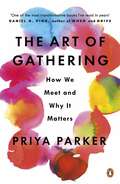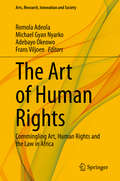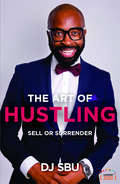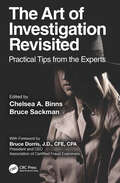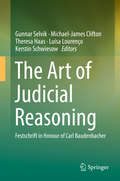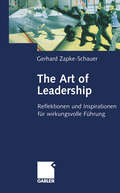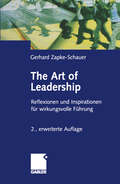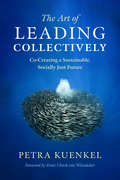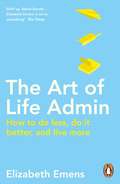- Table View
- List View
The Art of Followership: How Great Followers Create Great Leaders and Organizations (J-B Warren Bennis Series #146)
by Ronald E. Riggio Ira Chaleff Jean Lipman-BlumenThe Art of Followership puts dynamic leader-follower interaction at the forefront of discussion. It examines the multiple roles followers play and their often complex relationship to leaders. With contributions from leading scholars and practitioners from the burgeoning field of leadership/followership studies, this groundbreaking book outlines how followers contribute to effective leadership and to organizations overall. Drawing from various disciplines?from philosophy, to psychology and management, to education?the book defines followership and its myriad meanings. The Art of Followership explores the practice and research that promote positive followership and reveals the part that followers play in setting the standards and formulating the culture and policies of the group. The contributors include new models of followership and explore fresh perspectives on the contributions that followers make to groups, organizations, societies, and leaders. The book also explores the most current research on followership and includes insights and perspectives on the future of leader-follower relationships.
The Art of Gathering: Create Transformative Meetings, Events and Experiences
by Priya ParkerWe spend our lives gathering - first in classrooms and then in meetings, weddings, conferences and away days. Yet so many of us spend this time in underwhelming moments that fail to engage us, inspire us, or connect us. We've all sat in meetings where people talk past each other or go through the motions and others which galvanize a team and remind everyone why they first took the job. We've been to weddings that were deeply moving and others that were run-of-the-mill and simply faded away. Why do some moments take off and others fizzle? What's the difference between the gatherings that inspire you and the ones that don't? In The Art of Gathering, Priya Parker gets to the heart of these questions and reveals how to design a transformative gathering. An expert on organizing successful gatherings whether in conference centres or her living room, Parker shows us how to create moving, magical, mind-changing experiences - even in spaces where we've come to expect little.
The Art of Giving: Where the Soul Meets a Business Plan
by Charles Bronfman Jeffrey R. SolomonAn honest assessment for how to determine your individual relationship with charitable giving in today's world From world-renowned philanthropists Charles Bronfman and Jeffrey Solomon of the Andrea and Charles Bronfman Philanthropies comes a comprehensive guide on how to be a canny, street-smart, effective philanthropist, regardless of your income level. It is also a perfect companion for nonprofit program and development executives who would like to introduce donors to their work and their organizations. Despite their critical importance to philanthropy, donors have few resources for solid information about making their gifts-deciding what type of gift to give, how to structure it, the tax implications, what level of follow-up and transparency they should ask for and expect, and countless other complexities. This book fills that vacuum and helps you gain a special understanding of philanthropy as a business undertaking as well as a deeply personal, reflective process. Drawing on decades of experience, the authors offer a fresh, enlivening approach to the nonprofit enterprise that, too often, is undervalued and thought of as the province of the burnt-out and the overwhelmed. Along with its many candid insights and memorable anecdotes, The Art of Giving also offers instruction on how to create a business plan for giving that works for you.
The Art of Giving: Where the Soul Meets a Business Plan
by Charles Bronfman Jeffrey R. SolomonAn honest assessment for how to determine your individual relationship with charitable giving in today's world From world-renowned philanthropists Charles Bronfman and Jeffrey Solomon of the Andrea and Charles Bronfman Philanthropies comes a comprehensive guide on how to be a canny, street-smart, effective philanthropist, regardless of your income level. It is also a perfect companion for nonprofit program and development executives who would like to introduce donors to their work and their organizations. Despite their critical importance to philanthropy, donors have few resources for solid information about making their gifts-deciding what type of gift to give, how to structure it, the tax implications, what level of follow-up and transparency they should ask for and expect, and countless other complexities. This book fills that vacuum and helps you gain a special understanding of philanthropy as a business undertaking as well as a deeply personal, reflective process. Drawing on decades of experience, the authors offer a fresh, enlivening approach to the nonprofit enterprise that, too often, is undervalued and thought of as the province of the burnt-out and the overwhelmed. Along with its many candid insights and memorable anecdotes, The Art of Giving also offers instruction on how to create a business plan for giving that works for you.
The Art of Going Global: A Practical Guide to a Firm's International Growth
by Olga E. Annushkina Alberto RegazzoInternationalizing your firm presents both exciting opportunities and daunting challenges, regardless of your industry. While strategy will vary from firm to firm, this book provides a solid set of decision-making tools that will support you as you take your company global. Starting with the most important step – cultivating a truly international perspective in your senior management team – it sets out the pros and cons of each choice you will face as you define and shape a global strategy. With a pragmatic toolkit provided at the end of each chapter, The Art of Going Global will help to improve your decision-making capabilities in relation to a range of challenges, including:· Selecting foreign markets · Adapting your business model· Navigating uncertain global markets· Managing across cultures· Choosing between entry mode options With case studies and insights illustrating how to apply each toolkit, this book is ideal for practitioners, MBA students, and those in executive education. It will help you to consider a variety of alternative solutions for key managerial decisions on internationalization, the costs and benefits of different strategic scenarios, and ultimately drive you to create a clear global vision for your firm.
The Art of Human Rights: Commingling Art, Human Rights and the Law in Africa (Arts, Research, Innovation and Society)
by Romola Adeola Michael Gyan Nyarko Adebayo Okeowo Frans ViljoenThis book highlights the use of art in human rights, specifically within Africa. It advances an innovative pattern of thinking that explores the intersection between art and human rights law. In recent years, art has become an important tool for engagement on several human rights issues. In view of its potency, and yet potential to be a danger when misused, this book seeks to articulate the use of arts in the human rights discourse in its different forms. Chapters cover how music, photography, literature, photojournalism, soap opera, commemorations, sculpting and theatre can be used as an expression of human rights. This book demonstrates how arts have become a formidable expression of thoughts and a means of articulating reality in a form that simplifies truth and congregates resolve to advance change.
The Art of Hustling: Sell or Surrender
by DJ SbuPersuasiveness.Influence.A certain something that makes it impossible for people to say no.Call it what you will, some people have it. DJ Sbu certainly does. It’s the quality that has helped him evolve from an ambitious boy growing up on Tembisa’s rough streets to a DJ, an entrepreneur, an author, a philanthropist and a speaker who graces stages around the world.In The Art of Hustling Sbu shares the secrets to cultivating this irresistible quality. Using events that have shaped his own life, he reveals how a positive outlook, resilience, hard work and determination can help you win in every sphere.This inspiring read also acts as a practical handbook, showing you how to apply The Art of Hustling to become a winning salesperson. It is DJ Sbu’s firm belief that, if you know how to sell, you will never go hungry. He also believes that this simple skill holds the key to solving Africa’s considerable unemployment problem.His passion for youth development comes through loud and clear in this easy-to-read, easy-to-use handbook. Full of practical examples, sound advice and no-nonsense insights, it’s a must-have for every person who wishes to further their lives and their careers, whether in the corporate world or starting out on an entrepreneurial journey.DJ Sbu’s career is testimony to his strength, resilience and spirit of innovation; the very qualities needed to get ahead in today’s rapidly evolving business environment. In sharing his story, he hopes to ignite others’ success.
The Art of Insight: How Great Visualization Designers Think
by Alberto CairoLearn how expert data visualization designers reason about their craft In The Art of Insight: How Great Visualization Designers Think, renowned visualization designer and educator Alberto Cairo, in conversation with several leaders in the field, delivers an inspiring exploration of how they make design choices. The book is a celebration of visualization, and a personal journey that dives into subjects like: How the professional background and life experiences of every designer shape their choices of what to visualize and how to visualize it. What designers from different countries and cultures, and working in different fileds, such as data art, data analytics, or data journalism, have in common, or how they differ from each other. How designers reflect on research, ethical reasoning, and also aesthetic judgments, to make decisions such as selecting the most appropriate ways to encode data, or the most appealing visual style. Perfect for data scientists and data journalists, The Art of Insight will also inspire artists, analysts, statisticians, and any other professional who uses data visualizations.
The Art of Insight: How Great Visualization Designers Think
by Alberto CairoLearn how expert data visualization designers reason about their craft In The Art of Insight: How Great Visualization Designers Think, renowned visualization designer and educator Alberto Cairo, in conversation with several leaders in the field, delivers an inspiring exploration of how they make design choices. The book is a celebration of visualization, and a personal journey that dives into subjects like: How the professional background and life experiences of every designer shape their choices of what to visualize and how to visualize it. What designers from different countries and cultures, and working in different fileds, such as data art, data analytics, or data journalism, have in common, or how they differ from each other. How designers reflect on research, ethical reasoning, and also aesthetic judgments, to make decisions such as selecting the most appropriate ways to encode data, or the most appealing visual style. Perfect for data scientists and data journalists, The Art of Insight will also inspire artists, analysts, statisticians, and any other professional who uses data visualizations.
The Art of Investigation
by Chelsea A. Binns Bruce SackmanThe Art of Investigation examines the qualities required to be a professional, thorough, and effective investigator. As the title suggests, it delves into more than the steps and procedures involved in managing an investigation, it also covers the "soft skills" necessary to effectively direct investigations and intuit along the way. The editors and contributing authors are the best in their field, and bring a wealth of real-world knowledge and experience to the subject. There are several publications available on the nuts-and-bolts of the process and stages of an investigation. That ground has been covered. However, little has been published on the investigative skills required, the traits necessary, and the qualities endemic to an inquisitive mind that can be cultivated to improve an investigator’s professional skill-set. Each chapter discusses the applicability of the traits to the contributor’s own work and experience as an investigator. In doing so, the contributors provide a story—or set of stories—from their personal experience, which demonstrates a given trait and its importance in the course of their investigative work and career. This will be first-hand experience that will serve to help any investigative professional in the course of their work. The case examples included throughout are sometimes surprising, but always engaging and insightful. An investigator must keep an open mind above all else, and this book will "lift the veil" on the inner workings of an investigation, in addition to the thought processes and inner monologues of an investigator as part of that process. Key Features • Chapters highlight the qualities and traits—the "soft skills"—that are required, and which can be improved over time, to be a thorough investigator. • A veritable "Who’s Who" of renowned investigative experts lend their personal expertise and experience to this how-to manual for investigators. • A unique approach is applied and provides self-help advice for both new and experienced investigative and security professionals. • The book focuses on the learned, acquired, and intuitive skills of investigation—a nuanced but essential aspect of the investigative skill-set. The Art of Investigation will be a welcome addition to any investigator’s toolkit and will also be of interest to students in criminal justice, security, and Homeland Security programs, security consultants, corporate and private security professionals, and the legal community.
The Art of Investigation
by Chelsea A. Binns Bruce SackmanThe Art of Investigation examines the qualities required to be a professional, thorough, and effective investigator. As the title suggests, it delves into more than the steps and procedures involved in managing an investigation, it also covers the "soft skills" necessary to effectively direct investigations and intuit along the way. The editors and contributing authors are the best in their field, and bring a wealth of real-world knowledge and experience to the subject. There are several publications available on the nuts-and-bolts of the process and stages of an investigation. That ground has been covered. However, little has been published on the investigative skills required, the traits necessary, and the qualities endemic to an inquisitive mind that can be cultivated to improve an investigator’s professional skill-set. Each chapter discusses the applicability of the traits to the contributor’s own work and experience as an investigator. In doing so, the contributors provide a story—or set of stories—from their personal experience, which demonstrates a given trait and its importance in the course of their investigative work and career. This will be first-hand experience that will serve to help any investigative professional in the course of their work. The case examples included throughout are sometimes surprising, but always engaging and insightful. An investigator must keep an open mind above all else, and this book will "lift the veil" on the inner workings of an investigation, in addition to the thought processes and inner monologues of an investigator as part of that process. Key Features • Chapters highlight the qualities and traits—the "soft skills"—that are required, and which can be improved over time, to be a thorough investigator. • A veritable "Who’s Who" of renowned investigative experts lend their personal expertise and experience to this how-to manual for investigators. • A unique approach is applied and provides self-help advice for both new and experienced investigative and security professionals. • The book focuses on the learned, acquired, and intuitive skills of investigation—a nuanced but essential aspect of the investigative skill-set. The Art of Investigation will be a welcome addition to any investigator’s toolkit and will also be of interest to students in criminal justice, security, and Homeland Security programs, security consultants, corporate and private security professionals, and the legal community.
The Art of Investigation Revisited: Practical Tips from the Experts
by Chelsea A. Binns Bruce SackmanThe Art of Investigation Revisited: Practical Tips from the Experts examines the qual- ities required to be a professional, thorough, and effective investigator and is a follow up to the authors’ highly touted book, The Art of Investigation (2019). This book features a wholly new line-up of investigators, experienced professionals in the field, who delve into the "soft skills" that make an investigator effective. Each chapter examines a specific quality required to be a professional, thorough, and—most importantly—successful in this challenging discipline. The editors, and contributing authors, are all top in their field and bring a wealth of real-world knowledge and experience to the subject. While several publications exist on the procedures and steps of an investigation, few books cover the creative and intuitive skills required. Such traits are necessary to continually question in the face of investigative roadblocks, unique qualities endemic to an inquisitive mind that can be trained to improve an investigator’s professional skill set. Each chapter discusses the applicability of the traits and requirements to the contributor’s own work and experience as an investigator. In doing so, the contributors will provide valuable stories from their personal experience, which demonstrates their use or a given trait and its importance in the course of their investigative work and career. The case examples included throughout are engaging and, as is often the case, surprising. An investigator must keep an open mind above all else and this book seeks to "lift the veil" on the inner workings of an investigation and the thought pro- cess and inner monologue of an investigator as part of that process. The book is a welcome addition to any investigator’s toolkit and is also of interest to students in criminal justice, security and Homeland Security programs, security consultants, corporate and private security professionals, and the legal community. Chelsea A. Binns is an Assistant Professor and Director of the Center for Private Safety and Security at John Jay College of Criminal Justice. She is also the Director of John Jay’s Center for Private Security and Safety. Chelsea has a PhD in Criminal Justice from the CUNY Graduate Center and is a licensed private investigator and a certified fraud examiner. Prior to working at John Jay, she was an investigator for the City and State of New York and in the financial industry. Bruce Sackman served as the Special Agent in Charge, U.S. Department of Veteran Affairs (VA), Office of Inspector General, Criminal Investigations Division, Northeast Field Office. He is also a recently retired self-employed licensed private investigator in New York City specializing in healthcare related matters. He is a frequent lecturer on the topic of medical serial killers having spoken throughout the United States, Great Britain, United Arab Emirates, and Sweden.
The Art of Investigation Revisited: Practical Tips from the Experts
by Chelsea A Binns Bruce SackmanThe Art of Investigation Revisited: Practical Tips from the Experts examines the qual- ities required to be a professional, thorough, and effective investigator and is a follow up to the authors’ highly touted book, The Art of Investigation (2019). This book features a wholly new line-up of investigators, experienced professionals in the field, who delve into the "soft skills" that make an investigator effective. Each chapter examines a specific quality required to be a professional, thorough, and—most importantly—successful in this challenging discipline. The editors, and contributing authors, are all top in their field and bring a wealth of real-world knowledge and experience to the subject. While several publications exist on the procedures and steps of an investigation, few books cover the creative and intuitive skills required. Such traits are necessary to continually question in the face of investigative roadblocks, unique qualities endemic to an inquisitive mind that can be trained to improve an investigator’s professional skill set. Each chapter discusses the applicability of the traits and requirements to the contributor’s own work and experience as an investigator. In doing so, the contributors will provide valuable stories from their personal experience, which demonstrates their use or a given trait and its importance in the course of their investigative work and career. The case examples included throughout are engaging and, as is often the case, surprising. An investigator must keep an open mind above all else and this book seeks to "lift the veil" on the inner workings of an investigation and the thought pro- cess and inner monologue of an investigator as part of that process. The book is a welcome addition to any investigator’s toolkit and is also of interest to students in criminal justice, security and Homeland Security programs, security consultants, corporate and private security professionals, and the legal community. Chelsea A. Binns is an Assistant Professor and Director of the Center for Private Safety and Security at John Jay College of Criminal Justice. She is also the Director of John Jay’s Center for Private Security and Safety. Chelsea has a PhD in Criminal Justice from the CUNY Graduate Center and is a licensed private investigator and a certified fraud examiner. Prior to working at John Jay, she was an investigator for the City and State of New York and in the financial industry. Bruce Sackman served as the Special Agent in Charge, U.S. Department of Veteran Affairs (VA), Office of Inspector General, Criminal Investigations Division, Northeast Field Office. He is also a recently retired self-employed licensed private investigator in New York City specializing in healthcare related matters. He is a frequent lecturer on the topic of medical serial killers having spoken throughout the United States, Great Britain, United Arab Emirates, and Sweden.
The Art of Investigative Interviewing: A Human Approach To Testimonial Evidence
by Inge Sebyan BlackThe Art of Investigative Interviewing, Third Edition can be used by anyone who is involved in investigative interviewing. It is a perfect combination of real, practical, and effective techniques, procedures, and actual cases. Learn key elements of investigative interviewing, such as human psychology, proper interview preparation, tactical concepts, controlling the interview environment, and evaluating the evidence obtained from the interview. Inge Sebyan Black updated the well-respected work of Charles L. Yeschke to provide everything an interviewer needs to know in order to conduct successful interviews professionally, with integrity, and within the law. This book covers the myriad factors of an interview — including issues of evidence, rapport, deception, authority, and setting — clearly and effectively. It also includes a chapter on personnel issues and internal theft controls.Provides guidance on conducting investigative interviews professionally and ethicallyIncludes instructions for obtaining voluntary confessions from suspects, victims, and witnessesBuilds a foundation of effective interviewing skills with guidance on every step of the process, from preparation to evaluating evidence obtained in an interview
The Art of IT Management: Practical tools, techniques and people skills
by Robina ChathamBeing an IT manager for the first time can be daunting. With a focus on practical advice, this book will provide you with hints, tips and examples from the world of IT management, showing you that management is about people rather than process; it is an art rather than a science. All the stories you will read in this book are true; all the advice has been personally tried and tested; all the tools and techniques have been applied by other aspiring leaders with positive results.
The Art of IT Management - Practical tools, techniques and people skills: Practical Tools, Techniques And People Skills
by Chatham RobinaMany IT professionals who find themselves in a management position for the first time can find it daunting. With this book you will learn that management is about people rather than process or procedure, it is an art rather than a science. There is no one particular right way, your approach has to be geared to the individual and the task in hand. With a focus on practical advice, this book will provide you with theory, hints and tips, case studies and examples from the world of IT management. All the stories you will read in this book are true; all the advice has been personally tried and tested; all the tools and techniques have been applied by other aspiring leaders with positive results.
The Art of Judgment: 10 Steps to Becoming a More Effective Decision-Maker (The John Adair Masterclass Series)
by John AdairThe success of any organization or individual depends upon making good decisions, arrived at through the use of a sound judgment. Too often, this elusive characteristic has been misperceived as an unchangeable, entrenched element of our character, over which we have little control. In fact, judgment is an art – one that can be honed, developed and mastered.In The Art of Judgment, John Adair draws upon his decades of experience and expertise to provide a practical and fascinating insight into how you can harness the full potential of your judgement. These in-depth methods are summarised in 10 key principles, which include:- Thinking to Some Purpose- Experience – the Seedbed- Truth – the Leading Star- How to Share Decisions- The Role of ValuesWith the divisiveness of public discourse and the complexities of modern business, it is more difficult than ever to be sure that you're making the right decision. Adair provides a clear pathway to improving your judgment, beginning with an exploration of the machinations behind decision-making, before demonstrating how you can develop a stronger understanding and control of your judgment. This is an essential companion for any business leaders interested in making the best decisions for them and their organization. Good judgment is the secret behind any success, and also has the potential to accelerate one's own career. This book provides insight, expertise and inspiration for anyone looking to cultivate and develop their art of judgment.
The Art of Judgment: 10 Steps to Becoming a More Effective Decision-Maker (The John Adair Masterclass Series)
by John AdairThe success of any organization or individual depends upon making good decisions, arrived at through the use of a sound judgment. Too often, this elusive characteristic has been misperceived as an unchangeable, entrenched element of our character, over which we have little control. In fact, judgment is an art – one that can be honed, developed and mastered.In The Art of Judgment, John Adair draws upon his decades of experience and expertise to provide a practical and fascinating insight into how you can harness the full potential of your judgement. These in-depth methods are summarised in 10 key principles, which include:- Thinking to Some Purpose- Experience – the Seedbed- Truth – the Leading Star- How to Share Decisions- The Role of ValuesWith the divisiveness of public discourse and the complexities of modern business, it is more difficult than ever to be sure that you're making the right decision. Adair provides a clear pathway to improving your judgment, beginning with an exploration of the machinations behind decision-making, before demonstrating how you can develop a stronger understanding and control of your judgment. This is an essential companion for any business leaders interested in making the best decisions for them and their organization. Good judgment is the secret behind any success, and also has the potential to accelerate one's own career. This book provides insight, expertise and inspiration for anyone looking to cultivate and develop their art of judgment.
The Art of Judicial Reasoning: Festschrift in Honour of Carl Baudenbacher
by Gunnar Selvik Michael-James Clifton Theresa Haas Luísa Lourenço Kerstin SchwiesowThis book, formed as a series of essays in honour of Professor Carl Baudenbacher, addresses the very art of judicial reasoning, and features contributions from many of the foremost current or former national, supranational, or international judges. This unique volume is intended first and foremost for legal scholars, but its approachable style makes it readily accessible for students and for those with a general interest in the application of the law and justice in today’s multi-layered world. The collection of essays is rather more philosophical and reflective as opposed to doctrinal. Each contribution focuses on the nature and operation of justice, the independence of the judiciary, and on judicial style primarily from the perspective of the judges themselves. The book provides perspectives on what it means to be accountable and independent as a judge, the role of language and languages in the quest for justice, while other contributions acquaint readers with the some of the structures of courts themselves, or indeed question for whom judgments are written. Each chapter has been written by a presiding judge, or head of an institution and the book is divided into three parts: - Part I Art and Method- Part II Justice and the Judiciary- Part III Reasoning and Language(s)
The Art of Leadership: Reflektionen und Inspirationen für wirkungsvolle Führung
by Gerhard Zapke-SchauerDer Autor hat seine Briefe mit wichtigen Managern der Welt herausgegeben. Sie enthalten Reaktionen auf aktuelle Bücher der Managementliteratur oder Kommentare zu wichtigen Ereignissen in großen Unternehmen. Eine Fundgrube aktuellen Managementwissens in kurzweiliger Form.
The Art of Leadership: Reflektionen und Inspirationen für wirkungsvolle Führung
by Gerhard Zapke-SchauerDer Autor hat seine Briefe mit wichtigen Managern der Welt herausgegeben. Sie enthalten Reaktionen auf aktuelle Bücher der Managementliteratur oder Kommentare zu wichtigen Ereignissen in großen Unternehmen. Auch die zweite, erweiterte Auflage bieteteine Fundgrube aktuellen Managementwissens in kurzweiliger Form.
The Art of Leadership through Public Relations: The Future of Effective Communication
by Patrik SchoberThe pandemic, the war in Ukraine and the increasing pace and impact of climate change have brought significant new challenges to leaders of nations, organizations, and professions. These events have changed the way we work, trade and live our lives. They have also changed the expectations on how our leaders must communicate. Stakeholders now expect leaders to have a clear and transparent position on all the key areas that matter most to them. The Art of Leadership through Public Relations: The Future of Effective Communication is designed to address those changed expectations by asking the questions that communications professionals and industry leaders will need to be able to answer in the next 20 years. Public Relations expert Patrik Schober has assembled a cadre of icons of the PR industry who act as part expert and part futurologist, to provide expert advice and enable leaders to be prepared to meet their most important communications and business challenges. The Foreword of the book is written by Francis Ingham, Director General of the PRCA, and Chief Executive of the International Communications Consultancy Organisation.
The Art of Leadership through Public Relations: The Future of Effective Communication
by Patrik SchoberThe pandemic, the war in Ukraine and the increasing pace and impact of climate change have brought significant new challenges to leaders of nations, organizations, and professions. These events have changed the way we work, trade and live our lives. They have also changed the expectations on how our leaders must communicate. Stakeholders now expect leaders to have a clear and transparent position on all the key areas that matter most to them. The Art of Leadership through Public Relations: The Future of Effective Communication is designed to address those changed expectations by asking the questions that communications professionals and industry leaders will need to be able to answer in the next 20 years. Public Relations expert Patrik Schober has assembled a cadre of icons of the PR industry who act as part expert and part futurologist, to provide expert advice and enable leaders to be prepared to meet their most important communications and business challenges. The Foreword of the book is written by Francis Ingham, Director General of the PRCA, and Chief Executive of the International Communications Consultancy Organisation.
The Art of Leading Collectively: Co-Creating a Sustainable, Socially Just Future
by Petra Kuenkel Ernst Ulrich von WeizsäckerA guide to collaborative impact for leaders in industry, government, and social change networks Our world is facing unsustainable global trends—from climate change and water scarcity to energy insecurity, unfair labor practices, and growing inequality. Tackling these crises effectively requires a new form of leadership—a collective one. But, in a world of many silos, how do we get people to work together toward a common goal? That is one of the most important questions facing sustainability and social-change professionals around the world, and it is a question that Petra Kuenkel answers in The Art of Leading Collectively. Readers learn how to tackle system change for sustainable development, reimagine leadership as a collaborative endeavor, retrain leaders to work collectively, and manage diverse groups through a change process that has sustainability as a guiding focus. Drawing upon two decades of pioneering, internationally recognized work orchestrating multi-stakeholder initiatives, Kuenkel presents her chief tool, the Collective Leadership Compass, and shows others how to use it with large groups of diverse stakeholders to solve complex, urgent problems—particularly those that enmesh business activities, governance, human needs, and environmental impacts. The book offers many examples of collective leadership efforts involving corporate, public, and nonprofit sectors around the world. Readers learn about the processes that led to a sustainable textile alliance and set standards for sustainable cocoa and coffee production and trade, as well as those that helped nations rebound from war, develop sustainable infrastructure, and tackle resource conflicts with global businesses, to name a few. Kuenkel provides a clear roadmap for leaders from multinational companies involved in partnerships, international organizations engaged in cooperative development, public agencies, and interest groups—as well as for citizens seeking solutions to social and sustainability challenge
The Art of Life Admin: How To Do Less, Do It Better, and Live More
by Elizabeth EmensThis book will give you many hours of your life back.'Timely and necessary . . . a must-read' Cal Newport, author of Digital MinimalismEvery day, an unseen form of labour creeps into our lives, stealing precious moments of free time, placing a strain on our schedules and relationships, and earning neither appreciation nor compensation in return. Scheduling doctor's appointments. Planning a party. Buying a present. Filling out paperwork. This labour is 'life admin' - the kind of secretarial and managerial work necessary to run a life and a household.Elizabeth Emens was a working mother with two young children, swamped like so many of us, when she realised that life admin was consuming her. Desperate to survive and to help others along the way, she gathered favourite tips and tricks, admin confessions, and the secrets of admin-happy households.Drawing on her research and writing in a wholly original manner, Emens shows how this form of labour is created and how it affects our lives; how we might reduce, redistribute and even prevent it; what 'admin personalities' we might have; and how to deal with admin in relationships.The Art of Life Admin is the book that will teach us all how to do less of it, and to do it better.***'Reading The Art of Life Admin is like sitting down with a friend who knows exactly how it feels to be drowning in your To Do list, and throws you a very welcome lifeline to help you to make your way out'Brigid Schulte, author of the New York Times bestseller Overwhelmed'Every so often you come across a book that really does profoundly change how you see the world. This is just such a book - it will, by force of its own genius, reprogram your life and give you new tools for seeing things as they actually are'Tim Wu, author of The Attention Merchants'Emens maps the political, psychological and practical landscape of "admin hell" with humour and hopefulness. This intelligent, witty book will shed new light on everyone's to-do list'Dr Clare Carlisle Tresch, King's College London***From Ideas to Try:1) Find ways to make things end. For instance, try writing No Need to Reply (NNR) on texts and emails. Save others time; they might even return the favour.2) Start bypassing the to-do list when you face real-time admin requests. Email someone the information she wants while she's still standing there - so it never goes on your to-do list. 3) Spend your Admin Savings Time well. If you save yourself an hour, spend that hour doing something you really want - or need - for yourself.

